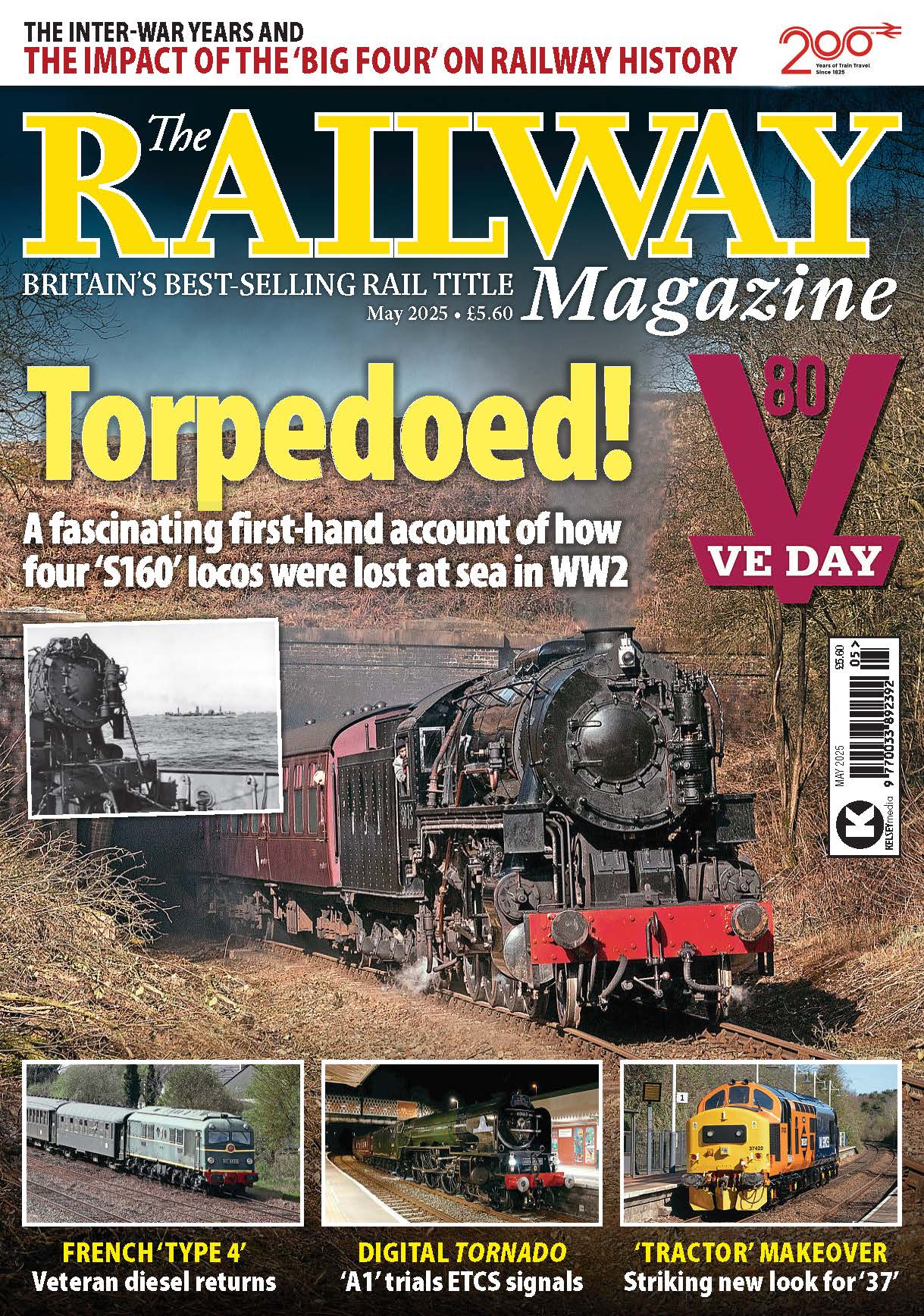This month (September 2016) marks the 40th anniversary of the arrival of the General Motors Class 071s in the Republic of Ireland. The ‘Big’ GMs (as they became known) went on to transform the nation’s loco-hauled services. Four decades later, they remain wholly intact as an operating class, as Gary Boyd-Hope explains.
THE date is Thursday, September 2, 1976 and the Lykes Line container ship MV Tillie Lykes is anchored off Dublin Bay; its massive 39,000-ton displacement prevents it from entering the Port of Dublin.
Tensions are high. The ship arrived at midday and to get its precious barge-mounted cargo to port it is having to be off-loaded in the bay, each barge being lowered gently into the water and towed by tug to North Wall for final unloading.
Unfortunately, bad weather is causing problems and delaying the operation, and it doesn’t look as though the first barge will reach North Wall until breakfast time the following day.
Monthly Subscription: Enjoy more Railway Magazine reading each month with free delivery to you door, and access to over 100 years in the archive, all for just £5.35 per month.
Click here to subscribe & save
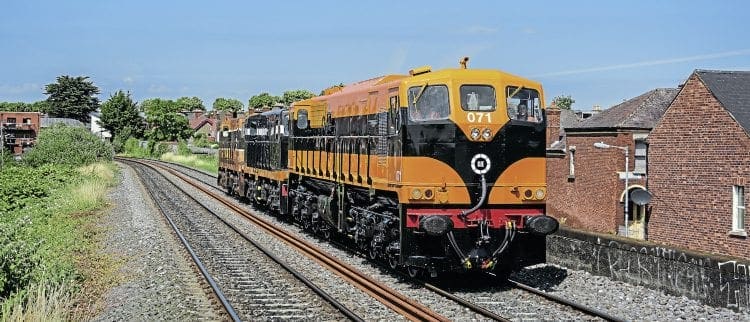
If this isn’t enough to bring a nervous sweat on, the activity has seemingly attracted the attention of a Soviet ‘spy trawler’ (this is the height of the Cold War), which has appeared to keep an eye on the proceedings, possibly to check that the cargo is not some form of American heavy weaponry.
American – yes. Weapons – no, unless the 18 brand new 2,475hp diesel-electric locomotives on board can be considered as part of Córas Iompair Éireann’s (CIÉ’s) front-line motive power arsenal. No-one can say what has brought the trawler in to snoop around, although it has been suggested that a simple confusion between the initials CIÉ and CIA could have been the cause. Whatever the reason, after a while, the trawler’s crew eventually seem satisfied that there is nothing untoward afoot and they depart the scene, undoubtedly to a chorus of relief.
The General Motors Class 071s have arrived.
American ascendancy
The need for a fleet of large high-power diesels was born largely from the relaying of the Dublin to Cork main line to allow for 90mph running, together with an aspiration to reach similar speeds over sections of the former Great Northern Railway (Ireland) Dublin to Belfast main line.
By this time CIÉ had already become firm bedfellows with General Motors, having taken delivery of 15 single-cab Class B121 Bo-Bo locomotives from GM’s Electro-Motive division (EMD) at La Grange, Illinois, in 1961. These had been followed in 1962 by 37 more Bo-Bos (the ‘B141s’) that were mechanically similar to the ‘B121s’ in having the same 950hp GM 8-567CR power unit, but with a cab at each end, and a further 12 locomotives similar to the ‘B141’ design in 1966 (the ‘B181s’), the latter featuring an uprated 8-645E 1,100hp engine.
Yet the GM monopoly went even further than that, for soon after the arrival of the Class 181s the American giant, after much toing and froing, agreed to supply two of its 12-645E 1,325hp engines to enable CIÉ to re-engine a pair (Nos. A58 and A59) of the failure-prone Metropolitan-Vickers ‘A’ class. The success of this experiment resulted in the remainder of the class being similarly treated, together with the smaller Metro-Vick ‘C’ class, which received GM’s 8-645E engines.
By the mid-1970s CIÉ had 206 operating diesel locomotives on its books from a total fleet of 221 units, with 170 of these being main line performers. Most were either General Motors-built or featured GM power plants, so reliability was not an issue. No, the main problems lay in the fact that most of these locos were in the 950 to 1,200hp range, not helped by low levels of availability owing to the number of locomotives that had been damaged in accidents or in bomb attacks connected to the ‘Troubles’ in Northern Ireland.
Top Link traffic was therefore in the hands of the rejuvenated ‘A’ class or pairs of the GM Bo-Bos working in multiple, and with the ‘A’ class – or ‘001’ class as they had now become – being restricted to 75mph, something new would be required if the dream of 90mph running was to be realised.
I should Co-Co
In mid-1974 CIÉ put out a request for tenders to supply a fleet of 18 powerful new locomotives, and it came as no surprise that General Motors emerged as the successful bidder.
The design submitted was for a 2,475hp Co-Co, employing the EMD two-stroke 12-cylinder, turbo-charged 645E3B engine.
GM’s classification for the new loco was JT22CW – the ‘J’ denoting ‘dual cabbed’,
‘T’ – turbo-charged, ‘22’ being the model number, ‘C’ signifying three axles per bogie, and ‘W’ the fact that it was built to Ireland’s standard gauge of 5ft 3in.
It was, to all intents and purposes, a standard General Motors design and mechanically shared many similarities to GM’s SDL39 type, built for the Milwaukee Road railroad a couple of years earlier. However, in order for it to suit Irish operating conditions it contained a number of modifications, most notably a cab at each end in typical European practice. In fact the body styling was modelled on that fitted to the earlier Class 141s and 181s, featuring a full-width cab at each end, separated by a narrow body shell with a railed walkway on either side. The result was a satisfying blend of European and American styling, of a sort that was later adopted by BREL when constructing the Class 58s.
The finished locomotives weighed in at just shy of 100 tons and measured 17.4m over buffers, were 4m high from rail level, and 2.9m wide. Of the 2,475hp gross developed by the engine, 2,250hp was available for traction, this being transmitted through D77 nose-suspended traction motors on each of the six axles. All locomotives also came with a power reduction system – a sort of Slow Speed Control – although this was later removed.
A significant change from the previous General Motors products employed by CIÉ was the adoption of a turbo-charged engine in the Class 071s instead of Roots blower used on the earlier machines. This was particularly evident when comparing the cylinder blocks of the new locomotives with the re-engined ‘001’ class, which although similar in dimensions, differed greatly in power output; the new locos grossed around 50% more power.
Building them was one thing, but getting them to Ireland was another thing entirely. In order to get them to New Orleans, where they would begin their journey across the Atlantic, they were loaded onto barges and conveyed down the Mississippi river. On arrival the barge/loco combinations were loaded in their entirety onto the 1973-built Tillie Lykes for their onward journey to Ireland. We have already discussed the circumstances surrounding their final transfer onto Irish soil; suffice to say that the poor weather of September 2, 1976 resulted in the tug Coliemore not reaching the quayside at North Wall until 08.50 the following morning.
The arrival of the ‘071s’ should have heralded the start of a new era for CIÉ and for high-speed rail travel across Ireland. Unfortunately, fate dictated this did not happen.
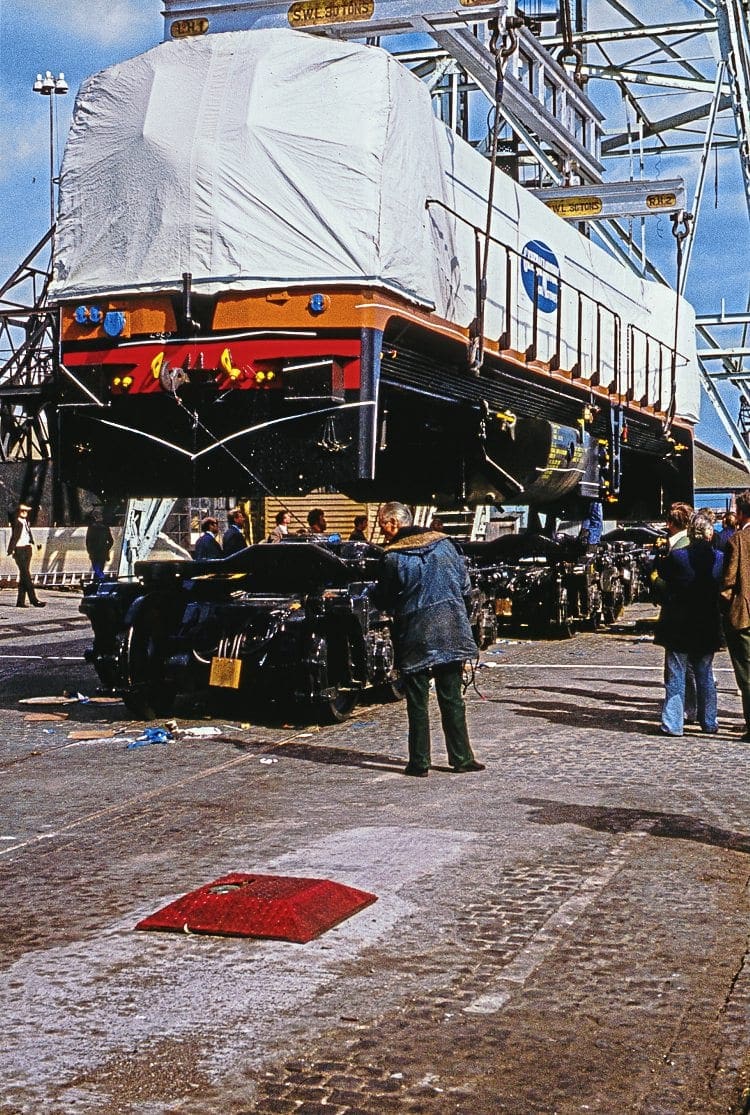
An inauspicious start
Unloading of the Class 071s took place in the days following their arrival; No. 080 was the last to be reunited with its waiting bogies and towed to CIÉ’s main works at Inchicore. Here, the locomotives must have presented a splendid sight to passengers in passing trains, lined up in their smart ‘Supertrain’ livery.
This was a brand new livery for CIÉ and consisted of an all-over golden brown, relieved by a broad black band midway up the body side, which wrapped around the cab fronts and tapered to a point above the buffer beams. In the centre of the cab fronts was the CIÉ ‘broken wheel’ logo, with the loco’s number being carried on the front and also on each cabside.
Numbering ran from 071 to 088 and initially just the number was carried. However, the suffixes ‘S’ and ‘A’ were later added to denote which of the class were fitted with CAWS (Continuous Automatic Warning System) and air brakes. These remained on later livery variants, with the coming of Irish Rail in 1987, but started being phased out in the early 1990s as they became redundant; the locos simply carried 071, 072 etc. from then on.
With the new fleet safely ensconced at Inchicore, CIÉ quickly began a programme of crew training and familiarisation so as to get the new flagship locos into revenue-earning service as soon as possible. This lasted into early October, but there was to be no fanfare or triumphant launch into traffic.
Instead the trade unions got involved, citing that the CIÉ drivers’ pay did not take into account the driving of new locomotives. Consequently, the entire ‘071’ fleet was blacked while negotiations were underway to settle the dispute. Both the unions and CIÉ stood their ground and the row rolled beyond Christmas and into 1977 before any kind of resolution could be agreed upon. In fact, it was not until May 23 that the first of the class finally entered traffic – No. 082 performing the honours on the 14.30 Dublin Heuston-Cork service.
Early service
The introduction of the Class 071s might not have gone the way that CIÉ had intended, but once in traffic they soon settled down and, apart from earning a reputation as rough riders, proved to be more than capable and justified CIÉ’s decision to buy American again.
The Dublin to Cork services were soon followed by those to Waterford and Galway, with the class taking over almost all of the fastest express services on routes radiating from Dublin, except on lines where their weight proved prohibitive. Interestingly, the route down to Rosslare was initially closed to them, as was that to Belfast, and it would be 1979 before the first of the class made it to Rosslare, and a further three years before Dublin’s ‘Enterprise’ services to Belfast were handed over to ‘071’ haulage. After that their route availability was almost universal; the final exception being the Ballina branch, and even this restriction was lifted in 1996 after the rebuilding of the River Moy bridge.
Northern Ireland interlude
The success of the Class 071s in service had not gone unnoticed by CIÉ’s rivals at Northern Ireland Railways (NIR), and in 1980 NIR took delivery of two of its own near-identical locomotives – Nos. 8111 and 8112.
Classified as the Class 111 and sporting NIR’s distinctive blue livery with small yellow warning panels, the two locomotives soon displaced the Hunslet-built Class 101s on Top Link services from Belfast.
A third locomotive – No. 113 – arrived in 1984. Locomotives Nos. 111 and 113 were subsequently renumbered by adding the prefix ‘8’ to fit in with the Translink vehicle numbering system. No. 112 has still to receive its new number. All are named after the main constituent companies of the NIR network: 8111 Great Northern, (8)112 Northern Counties and 8113 Belfast & County Down.
Grim reading
Back in Dublin the Class 071s were performing sterling, if unremarkable work, but on August 1, 1980 class member No. 075 made the headlines for all the wrong reasons.
At 12.45 that day, while hauling the
12-coach 10.30 Dublin Heuston-Cork service through Buttevant, County Cork, No. 075 hit a set of temporary facing points and was diverted off the main line and into a siding, while travelling at around 60mph.
The locomotive remained upright and suffered only front-end plate damage, but the generator van and coaches immediately behind the loco jack-knifed across the lines; three of the wooden-bodied coaches were completely destroyed.
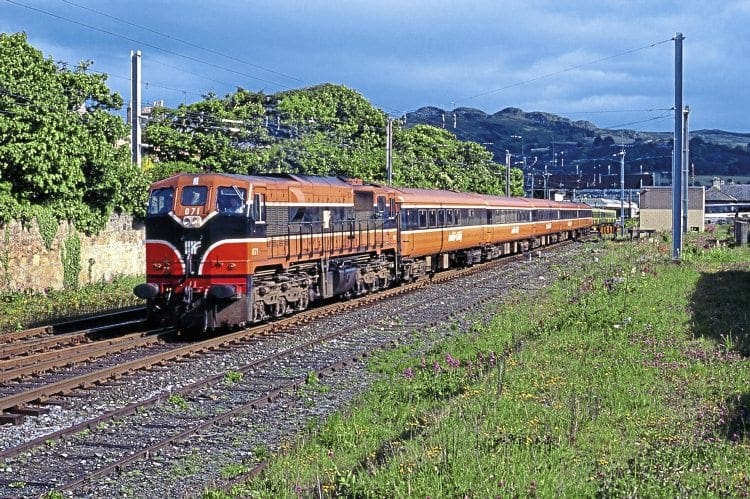
Sadly, of the 230 passengers on board (it was a bank holiday), 18 were killed and 70 more injured.
The points had, it turned out, been installed only a few months previously, but were not connected up to the signal cabin. At the time of the incident they had been set against the train by a team of permanent-way staff, who had been expecting another locomotive, already stationed in the Up platform at Buttevant, to move into the siding. However, they had done so without obtaining permission from the signalman who, upon realising what was unfolding, manually set the signals to ‘danger’ and told the pointsman to reset the points. Sadly, No. 075 was travelling too fast to avoid disaster.
A little more than three years later, at 21.40 on August 21, 1983, ‘071’ No. 086 ploughed into the rear of the 17.15 train from Tralee to Dublin, which had stalled on the embankment at Cherryville Junction after its locomotive – ‘A’ class No. 009 – had run out of fuel. No. 086 was working the 18.50 Galway-Dublin Heuston train at the time of the incident, which claimed the lives of seven passengers and injured another 55.
Neither accident had been caused by any fault with the ‘071s’, but as the 1980s progressed the class developed something of an Achilles heel, with certain members starting to suffer cracks in the frames near the bogie centre pivot, the cause of which remains unclear. As a precaution CIÉ elected to put the entire class through Inchicore for remedial attention, their duties being handed back to the ‘A’ class (‘001s’) in the short-term, no doubt to the delight of many photographers.
One of the most significant upshots of the Buttevant and Cherryville disasters was that CIÉ came under severe public pressure to improve safety and to modernise the carriage fleet. A subsequent review of the national rail safety policy resulted in the rapid elimination of wooden-bodied stock, with the decision being made to buy a fleet of modern coaches based on British Rail’s Mk3 design. The new vehicles were built by BREL in Derby, and under licence by CIÉ at Inchicore, between 1983 and 1989.
Some of these new Mk3s emerged in a ‘Revised Supertrain’ livery, and over time the Class 071 fleet was repainted to match. The new paint scheme was very similar in appearance to the original version, but the golden brown was replaced by a much brighter orange, and the CIÉ ‘broken wheel’ logo on each end was in orange instead of white.
New paint scheme
This livery was further revised in early 1987 upon the formation of Irish Rail, a wholly owned CIÉ subsidiary set up to take over the running of the nation’s railways. The new paint scheme was effectively the same orange & black as in the ‘Revised Supertrain’, but with white stripes separating orange & black areas. The CIÉ roundel on the front gave way to the new corporate IR ‘four tracks’ logo, which also made an appearance on the body sides.
The first locomotive to carry the new livery was No. 078, which entered service in its new guise on April 16, 1987, working the 11.35 Dublin Heuston-Waterford service.
There subsequently followed a period of cross-over between the ‘Revised Supertrain’ livery and the new ‘White Stripe IR’ variant, whereby some locomotives still carrying the earlier orange & black livery had the new IR logo applied, but without receiving the white stripes. However, all locos later received the new look.
As the 1980s gave way to the ‘90s, the engineers at Inchicore had begun to look at ways of curing the poor riding characteristics of the ‘071s’, and from 1992 the class was retro-fitted
with yaw dampers as they passed through the works. Another modification to take place around this time was an upgrade of the power plant to the 12-645E3C.
Loco No. 084 received particular attention after being involved in a derailment at Belview on July 11, 1993, while working the 18.45 ‘Gaelic Athletics Association’ special from Dublin to Rosslare Harbour via Waterford. Once again the locomotive was not to blame and a track fault was found to be the cause of the incident. Mercifully, there were no fatalities on this occasion and even the loco remained upright.
No. 084 provides a nice link into the next livery change for the ‘071s’, for this was the last of the class to carry the later variation of the ‘White Stripe’ livery. In 1994 Irish Rail elected to bring the Irish version of its name – Iarnród Éireann – to the forefront, and as such a new stylised version of the letters IE, which brought to mind a three-pin plug, came into common use as the new logo. Loco No. 086 was the first to be so treated, with the new logo later finding its way onto all members of the class. The livery was subtly changed later on by the addition of dayglow orange warning panels in the bottom corners of the cab fronts; the aforementioned No. 084 retained this livery until May 2013.
In November 1992, Irish Rail formally placed an order with General Motors for a fleet of 10 new 3,200hp Co-Co locomotives. This order was later increased to 32 units, thanks to some additional EU funding, with the build being completed at GM’s Canadian plant in London, Ontario. In addition, Northern Ireland Railways also ordered two units for cross-border ‘Enterprise’ operations.
On June 9, 1994 the first of the new Class 201s – No. 201 – made headlines around the world when it arrived at Dublin Airport in the hold of a gigantic Ukrainian Antonov 124 cargo plane. Bearing a marked family resemblance to Foster Yeoman’s Class 59s, the ‘201s’ were capable of 102mph running and had been designed to eliminate the need for generator vans in passenger trains (something in which they ultimately failed), and some even came push-pull capable.
The remaining class members all arrived by sea, and all except two were wearing a striking new orange & yellow livery with the new Iarnród Éireann ‘three-pin plug’ logo on the body sides. The two exceptions being the two Northern Ireland Railways’ locomotives being delivered in all-over blue livery.
The entry of the ‘201s’ into traffic was swift and the Class 071s quickly found themselves displaced from the Top Link expresses and transferred to working the lines to Waterford, Rosslare and Sligo. Freight was also a staple diet for the class, being regular performers on the Mallow to Wellington Bridge sugar beet trains, the Sligo to Waterford timber traffic, the Esso and ‘Norfolk’ liners (fully fitted freights), and Tara Mines zinc ore trains.
It was while working a freight that No. 075, the same engine that featured in the 1980 Buttevant disaster, managed to fall foul once more. The loco had been hauling a cement train bound for Adelaide Yard, in Belfast, on April 7, 1998, when it ran into the back of a Dundalk to Adelaide Yard Guinness liner (being worked by Class 141 No. 149) at Finaghy, to the south-west of Belfast. No. 075 received severe damage to its cab and ended up leaning at a 45° angle.
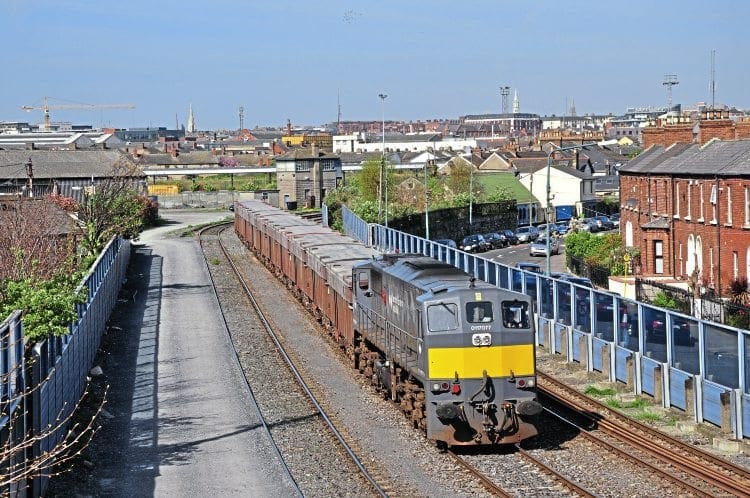
Economic boom
The status quo remained throughout the 1990s and into the 2000s, with Ireland being the place to go for loco-hauled passenger trains, while the onward march of the DMU and EMU largely killed off such traffic in Great Britain.
However, the ‘Celtic Tiger’ was not going to be left behind, and the economic boom years saw considerable investment made by Iarnród Éireann in its railways. One of the most
significant was the decision to move away from
loco-hauled trains with the introduction of the Japanese Class 22000 railcars (DMUs) from 2007. The widespread use of the Class 22000s on InterCity, outer suburban and regional services resulted in the ‘071s’ losing the last of their passenger turns, and they were cascaded down onto freight working, in turn displacing the last of the GM Class 141 and 181s, which were ultimately withdrawn.
For the railways of Britain, privatisation had introduced a new element of colour as an antidote to the decades of ‘Rail Blue’, and across the Irish Sea similar moves were afoot to eradicate the all-pervading corporate orange.
In March 2007, No. 081 rolled out of Inchicore sporting a new livery featuring silver cabs with yellow front panels, together with black body sides, with the ‘three-pin plug’ logo. This new livery was later applied to Nos. 071, 072, 073, 074, 075, 076, 079, 080, 082, 083, 085, 086 and 088.
In some ways though it was only a token gesture as freight had taken a major nosedive by this point.
Iarnród Éireann had closed its container rail freight business on July 29, 2005, stating that the sector accounted for only 10% of its freight business, against 70% of its losses. The container gantries at Sligo and Mallow were therefore removed in 2006, about the same time that the sugar beet traffic had come to an end. The conveyance of cement ended in 2008, along with the timber traffic from Sligo, and the following year saw the cessation of shale traffic from Kilmastulla to Limerick/Castlemungret.
By 2009 things were at an all-time low.
40 years intact
The downturn in freight and loco-hauled passenger work also had a big impact on the Class 201s; in 2009 the non-push-pull examples (Nos. 201–205 and 210–214) were taken out of traffic and stored at Inchicore, mainly due to the introduction of the Class 22000 railcars and the withdrawal of the Mk3 carriage fleet.
However, the Class 071s have not been affected and, at the time of writing, all 18 members of the fleet remain in service.
All are confined to freight working, with the occasional railtour duty thrown in for the Railway Preservation Society of Ireland, the Irish Railway Record Society,
or Railtours Ireland.
Even the three Northern Ireland Railways examples are still in traffic, with infrastructure trains being their main source of work, and No. 112 spending an extended period on hire to Iarnród Éireann from 2003. There was a proposal in 2007 that the locomotives would be converted for push-pull operation to work with a set of ex-Gatwick Express coaches and a purpose-built DBSO. The plan, however, came to nought, the coaches being sold to the RPSI and the DBSO finding a new home at the Downpatrick & County Down Railway.
Since the dark days of 2009 freight has seen something of an upturn, with the ‘071s’ being regular performers on the International Warehousing & Transport (IWT) chartered liner from Ballina to Dublin Port (North Wall) and the twice-weekly DFDS ‘Intermodal’ containers from Ballina to Waterford Port (Belview). Meanwhile, timber trains from Ballina and Westport to Waterford Port are run for the forestry company Coillte, and not forgetting the thrice-daily zinc ore trains from Tara Mines at Navan to North Wall.
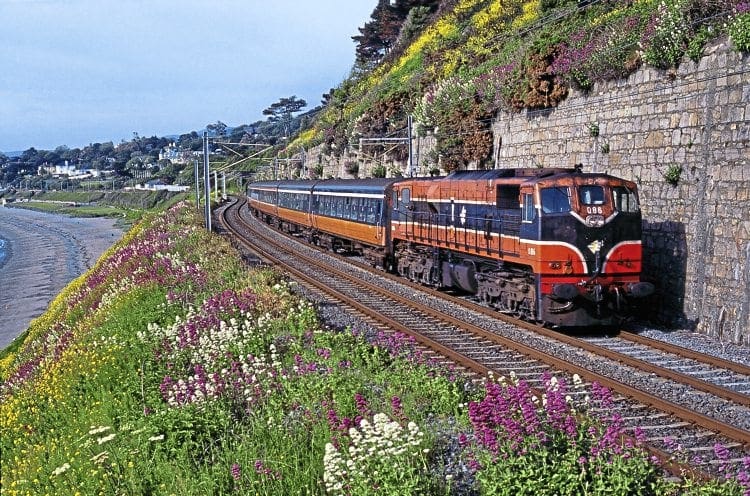
In 2013 a further new livery was introduced for the ‘071s’ in the form of an
all-over slate grey with the new bi-lingual Iarnród Éireann-Irish Rail crest on the sides. No. 077 was the first to be so treated in April of that year, with others receiving the livery as they have gone through works.
To date Nos. 071, 076, 077, 078, 080, 081, 084, 085, 087 and 088 have been repainted, and Nos. 077, 078, 084 and 087 have gone straight from the later IE orange, bypassing the silver paint scheme altogether.
The new livery has been well-received and makes the locomotives look considerably more modern than their 40 years. However, a peculiarity is the European diktat that each should carry small case full European Vehicle Numbers (EVN) on the cab sides, with a shortened EVN number on the cab front.
The locomotives also carry their fleet number (071, 072 etc.) in a larger case on cabsides and cab fronts to ease identification.
The full numbers carried so far are (shortened numbers are in brackets):
071 – 92 60 117071-7 (0117071)
076 – 92 60 117076-6 (0117076)
077 – 92 60 117077-4 (0117077)
078 – 92 60 117078-2 (0117078)
080 – 92 60 117080-8 (0117080)
081 – 92 60 117081-6 (0117081)
084 – 92 60 117084-0 (0117084)
085 – 92 60 117085-7 (0117085)
087 – 92 60 117087-3 (0117087)
088 – 92 60 117088-1 (0117088)
Back to the start
It would have been a crying shame to let the 40th anniversary of this reliable fleet of workhorses go by without any form of recognition, a thought also shared by Neil Dinnen, IE’s InterCity fleet controller.
He therefore suggested to Inchicore’s chief mechanical engineer, Peter Smyth, the possibility of repainting one of the locomotives into the original ‘Supertrain’ livery.
The idea gained momentum and at the end of April this year class pioneer No. 071 was despatched to the Inchicore paint shop.
The repaint took just under two weeks to complete, the ‘Big’ GM emerging in the ‘Revised Supertrain’ livery on May 11, albeit with the earlier plain white CIÉ ‘broken wheel’ logo on the cab fronts.
An etched plaque on the side of the loco reads ’40 Years 1976-2016’.
The resplendent No. 071 was the star turn on the RPSI’s ‘071 40th Anniversary Railtour’ on May 13, and has since returned to day-to-day running.
What the next few years have in store for the Class 071s is anybody’s guess.
The upturn in freight traffic could keep them gainfully employed for the foreseeable future, although Iarnród Éireann-Irish Rail’s plans to run heavier and longer container trains, using the Class 201s, could take away one of their main avenues for work.
That said, the ‘071s’ remain the preferred option on engineering trains owing to them being cheaper to run than the Class 201s, and their universal route availability.
Best to enjoy that distinctive roar while we can! ■
■ Special thanks to Peter Jones of the Irish Traction Group, Ciarán Cooney from the Irish Railway Record Society, and Gregg Ryan, Irish Rail’s recently retired heritage officer, for their assistance in preparing this article.
The Railway Magazine Archive
Access to The Railway Magazine digital archive online, on your computer, tablet, and smartphone. The archive is now complete – with 120 years of back issues available, that’s 140,000 pages of your favourite rail news magazine.
The archive is available to subscribers of The Railway Magazine, and can be purchased as an add-on for just £24 per year. Existing subscribers should click the Add Archive button above, or call 01507 529529 – you will need your subscription details to hand. Follow @railwayarchive on Twitter.



